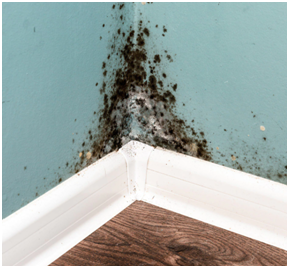Black mold is a fungus that typically develops in damp and poorly ventilated areas in the house like the bathroom and kitchen. Continuous exposure may cause serious health issues. Many people aren’t aware to recognize black mold or understand its health risks. In this blog, we answer the question of what is black mold, discuss its causes and treatment, and explore how to prevent it.
What is Black Mold?
Black mold or Stachybotrys chartarum grows indoors, in areas with high humidity and moisture levels. It is called black mold because of its dark greenish-black color. Black mold is not always visible. If there is a musty earthy smell in the room, most likely black mold is growing.
Black mold has mycotoxins that are harmful to both humans and animals when inhaled or ingested. Repeated exposure can cause common health conditions such as headaches, fatigue, and skin irritation, and more serious illnesses like respiratory diseases and even memory loss.
What Causes Black Mold?
The most common cause of black mold is the accumulation of moisture in homes or buildings. If an area has poor ventilation or high humidity, or if there are leaking pipes in the building, black mold may grow. The areas in the house that are likely to have black mold are the bathroom, kitchen, and basement.
One of the causes of the growth of black mold is water leaks:
- This may come from leaks in roofs, pipes, or windows. Constant flooding in your area due to rains may also cause the growth of black mold.
- If not cleaned and dried, the affected areas can become a breeding ground for black mold spores.
Another contributing factor is poor ventilation:
- When air circulation is limited, humidity levels increase, creating an ideal environment for mold growth.
- This is why it is essential to ensure that bathrooms and kitchens have proper ventilation systems in place and that any moisture or condensation is promptly wiped.
Black Mold Treatment
The first step in black mold treatment is to identify and remove the source of moisture causing the mold to grow. You may have to fix pipe leaks, repair damaged roofs or windows, or install dehumidifiers to reduce humidity levels. After identifying the source, thoroughly clean the affected area using mold remediation products.
To ensure the removal of all traces of mold, you may need to replace your drywall or carpet. Wear protective gear like gloves and masks during the entire process to avoid further exposure.
Black mold treatment requires a comprehensive approach that addresses the source of the moisture and the mold itself. With prompt action and proper cleaning techniques, you can eliminate black mold and restore a healthy living or working environment.
Black Mold Prevention
Preventing black mold from growing in your home or office is essential to maintain a healthy living or working environment. The key to prevention is to keep the indoor environment dry and well-ventilated. You can achieve this by fixing leaks promptly, installing proper ventilation systems, and using dehumidifiers to reduce humidity levels.
Regular cleaning helps prevent mold growth. Make sure to clean areas prone to moisture, such as bathrooms and kitchens, regularly using mold-inhibiting products. In addition, address any water damage or leaks promptly, as these are common causes of black mold growth.
If you suspect that you have a mold problem, contact a professional mold inspection company, like Golden State Mold Inspections. A mold inspection will help identify the source of the problem and determine the appropriate course of action to prevent further growth and potential health hazards.
The Health Effects Of Black Mold Exposure
Exposure to black mold can cause serious health issues. People who are prone to allergies or respiratory problems are at risk. Inhalation of black mold spores can cause coughing, sneezing, and wheezing. Some people may even develop severe respiratory problems, including asthma attacks and bronchitis.
Exposure to black mold can also cause headaches, fatigue, and difficulty concentrating. Some individuals may experience skin irritation or allergic reactions, such as hives or rashes. Prolonged exposure to black mold may lead to neurological issues and immune system suppression.
Be cautious around black mold if you have a weakened immune system or pre-existing health conditions. Pregnant women, children, and the elderly are also more susceptible to the negative health effects of black mold exposure.
Conclusion
Black mold is a type of fungus that grows in humid environments. Black mold can cause health problems, including respiratory issues, allergies, and even neurological problems in some cases. If you suspect that you have black mold in your home or workplace, consult a professional immediately.
If you have any further questions about black mold or mold remediation, please do not hesitate to contact Golden State Mold Inspections.

